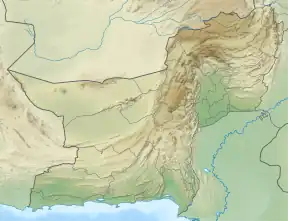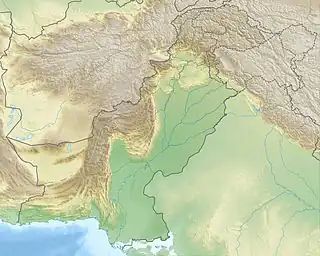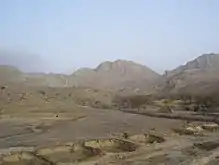Lahoot Lamakan
Lahoot Lamakan (Urdu: لاہوت لا مکاں) is a sacred cave in Balochistan, Pakistan.[1]
| Lahoot Lamakan | |
|---|---|
| Urdu: لاہوت لا مکاں | |
 A view of cave at Lahoot La Makan. | |
  | |
| Location | Balochistan, Pakistan |

Shrine
Tuhfat al-Kiram — primarily, a chronicle of Sufis in Sindh by Mir Ali Sher Qaune Thattvi (c. mid-eighteenth century) — that one Bilawal Shah Noorani of Thatta was afflicted by divine frenzy, and had to leave the town in the late fifteenth century during the reign of Jam Nizamuddin II.[2] He ventured west of Thatta and ended up in the valley, usurping the orchards of one Gokal Seth.[2]
The site draws thousands of Shia Muslim pilgrims every year, who take a fortnight-long pilgrimage to the valley, starting from the shrine of Lal Shahbaz Qalandar Sehwan and stopping by at small shrines (or stations) in the way.[3][4][lower-alpha 1] However, the primary subject of veneration is not Shah Noorani but Ali, a cousin of Muhammad and the first Shia Imam.[2] A footprint is alleged to be that of Ali, cast while he had dismounted from his horse to fight "Gokul Deo"; another footprint is attributed to the hoof of his horse.[2][lower-alpha 2] There is also a cave, where Shah Noorani had allegedly spent his last days; inside lies a stone which is argued to be the image of Ali's camel.[2][lower-alpha 3]
Notes
- These stops are in order: Lalbag in Sehwan; Shrine of Sain Ali Raza Shah in Jhangara; Panjtan Ja Chashma, a spring; Shrine in Naing Sharif; Baga Shir; Haoot Cave; Shah Ja Kanda; a spring at Noor Wahi; Chung Mountain; Har Mori; Mai Ji Kandri; Dargah Syed Bahlool Shah Dewano; Shinh Lak; Mosque at Khooi.[3]
- Salman Rashid quips that the relationship of the two footprints were too askew to allow Ali from dismounting his horse![2]
- Local Hindus claim that the cave was a sacred site for Hindus before its incorporation into Sufi networks and the stone is actually a lingam. Jürgen Schaflechner finds the claims convincing, going by the shape of the stone.
References
- "The historical beauty of Balochistan". May 21, 2019.
- Rashid, Salman (31 August 2012). "Tales from Lahoot valley - The Express Tribune". Tribune.com.pk. Retrieved 2018-04-07.
- "Khuzdar's Shah Bilawal Noorani shrine: A journey of devotion - Pakistan". Dawn.Com. 2016-11-13. Retrieved 2018-04-07.
- Delage, Rémy (2016-07-01). "L'espace du pèlerinage comme « territoire circulatoire » : Sehwan Sharif sur les rives de l'Indus". Les Cahiers d'Outre-Mer. Revue de géographie de Bordeaux (in French). LXIX (274): 77–102. doi:10.4000/com.7863. ISSN 0373-5834.